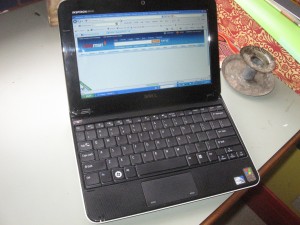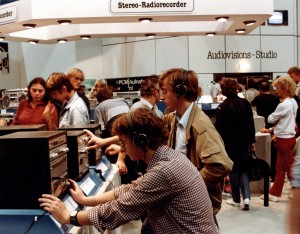HomeNetworking01.info – 1 year young
A summary post of the year in review for home and small-business Information Technology
Technological Changes and Events
Arrival of Windows 7 and MacOS X “Snow Leopard”
Windows 7 and Macintosh “Snow Leopard” have been primarily “under-the-hood” reworks of the operating systems in order to make them perform in an optimum manner on today’s hardware. This has led to both of them being fine-tuned to work properly with the latest Intel-architecture processors, both the 32-bit versions and the 64-bit versions.
The main benefit is that Windows has been brought up to the same performance expectation as the Macintosh platform especially when it come to graphics and multimedia tasks. This also has affected the industrial design of Windows-based computer hardware where the computer systems, especially portable computers (laptops, notebooks and netbooks) and “all-in-one” computers which have the computing power integrated with the LCD screen, are aesthetically on a par with or overtaking the Apple Macintosh computers, especially the MacBook portable computers and the iMac all-in-one units.
There will still be the Macintosh users who crave the glowing Apple logo on the back of the computer but an increasing number of these users are still considering the Windows 7 platform.
The rise of the netbook
This year has seen the netbook become a significant computing option. These compact portable computers run on a processor like the Intel Atom platform, use a screen of up to 11” and have as their secondary storage a hard disk of up to 160Gb and a memory card reader but no optical-disk drive. As far as networking is concerned, they will usually have Wi-Fi wireless networking at least and may also have wireless broadband connectivity built in to them. These grew out of the “One Laptop Per Child” project where the goal was to provide portable computers to children in underdeveloped communities, especially the Third World, to assist with their education.
They are now being seen as being of value to computer users who have a desktop, larger laptop or “all-in-one” as a secondary computer for use when travelling or for computer users who consider that their only needs are word-processing, email and Web surfing. They also have become of value to “hotspot surfers” who make regular visits to cafes, bars and similar locations where a wireless hotspot exists.
Apple iPad and the arrival of the consumer tablet computer
Another significant technological event that had happened this year was Apple launching the iPad. This is a touch-sensitive portable computing device about the size of an average magazine and is supported by an electronic book and periodical library provided by Apple’s iTunes infrastructure.
It has attracted a lot of curiosity and interest from consumers, publishers and competitors alike and there has been interest in it being a platform for delivering books, newspapers, magazines and other printed material. It has been taken further with the concept of rich media and video as part of illustrations in the electronic publications.
Of course, competitors have answered the device in different ways. One was to provide low-cost touch-enabled convertible notebooks including “netvertibles” which are touch-enabled convertible netbooks. These units would run the Windows 7 Home Premium operating system or another “tablet-form” operating system. Another was to provide touch-enabled “tablet” computers that run Android or another competing consumer-electronics operating system. They would also run “front-ends” for various electronic-publishing platforms like Amazon and / or provide PDF reading functionality.
The ultra-cool Apple iPhone faces serious competition
Google had officially released the Android embedded-device operating system and this led to the arrival of touch-enabled smartphones from HTC, Samsung, Motorola and Sony Ericsson which were able to effectively compete with the Apple iPhone. This operating system was backed by an application development environment and on-phone “app store” that gave developers more freedom to do what they want with their applications.
Similarly, Samsung had developed Bada, which was their own touchscreen smartphone platform and supplied a number of smartphones that ran on this platform. Other smartphone platform designers like RIM, Symbian and Microsoft had prepared touchscreen smartphone platforms and app-store environments that were able to compete with Android and the Apple iPhone platform.
The arrival of the competing platforms had occurred concurrently with an increased developer dissatisfaction with the way Apple handled iPhone apps for sale through through the iPhone App Store. This dissatisfaction has also been intensified by the “found iPhone 4 prototype” saga which engulfed the Gizmodo blog circa May and June, where Apple wanted to haul that blog and one of its reporters “over the coals” because they were perceived to be spying on their trade secrets.
Next generation broadband
Another major technological change that has happened over this year was the arrival of next-generation broadband in an increasing number of countries with the most progressive rollouts being in UK, France and Germany.
This is a category of broadband service that gives network bandwidths of at least 10Mbps to the customer’s door. Most such services use a backhaul that is primarily fibre-optic cable but there are some that use fibre-optic cable to the customer’s door whereas others use copper-based technology, usually VDSL2 which is a fast version of ADSL2 optimised for short runs.
Major promises that have been offered with this technology include the delivery of IP-based TV services that provide many streamed or on-demand channels of high-definition video as well as IP-based voice and video telephony with the voice service at the sound-quality equivalent of FM radio.
TV content delivered over the Internet
This leads me to an increased interest being shown by broadcasters, Internet service providers and the consumer-electronics industry in delivering TV content via the Internet. This encompasses content streamed in real-time to the end-user in the traditional broadcast context and video-on-demand content able to be drawn down by the end-user for immediate viewing or storage on a hard disk local to the end-user’s home.
Some European countries are using this technique to provide free-to-air TV and pay TV through “triple-play” Internet services. But the technology is being considered in the USA and Australia as an alternative to pay TV. This is being considered more so in the US especially during the Financial Crisis because of a desire to save money by “cutting the cord” – disconnecting from cable TV and is augmented by the fact that a lot of Americans are becoming disenfranchised by their cable-TV providers.
TV over Internet has been augmented by the development of the Google TV platform and consumer-electronics manufacturers developing their “online-TV” platforms that are part of their TVs and Blu-Ray players. These platforms include a front-end to various video-on-demand or IPTV services as well as social-Web services like Facebook and Twitter. Even Panasonic, LG and Samsung have integrated Skype in to their TV platforms and provided support for a Webcam so that their TVs become a large-screen communal videophone of the kind only dreamed of in science fiction.
As well, companies like TiVo and Sony are proposing that the FCC (the communications regulator in the USA) implement a standards-driven “broadcast-IP” way of delivering premium TV services, both broadcast and on-demand, to the networked home. This is to be considered as a preferred alternative to the status quo of delivering pay-TV where the signal is delivered from the cable-TV infrastructure or satellite dish to set-top boxes that are leased from the pay-TV provider at each viewing location. The DLNA-driven setup would provide for viewing and recording of regular broadcasts, viewing of on-demand content as well as use of interactive TV using equipment purchased by the consumer and supporting the ability to have the user experience branded by the equipment’s designer for example.
On this site
Naming change from cumbersome name to simple HomeNetworking01.info name
This site used to be known as the “Home Networking Information And Discussion Blog” but has been rebranded to an easily-remembered “HomeNetworking01.info” brand. This reflects the actual URL address for this site rather than the URL referring to a cumbersomely-worded site name.
As well, the site isn’t just pitched as a blog. With all the many feature articles and product reviews, this site is positioned as an information portal for home and small-business information technology.
Plenty of reviews
Over the past year, I had built up strong relationships with various names in the consumer and small-business IT scene in order to review network-enabled equipment for this class of user. I have focused on equipment that can be managed by the user themselves, especially that the householder or small-business owner is likely to be the one who manages all of the equipment rather than relying on dedicated staff or outside contractors.
I have reviewed network-based media players that support UPnP AV media playback as a standard. This encompasses the Internet radios that I have reviewed here because they are able to fulfil the role of a network media player as well as an Internet radio.
It has been dominated by a lot of table radios, mostly made by Revo; plus one Pure Evoke Flow portable radio and a Sony home-theatre receiver that was primarily a network media player.
I have also reviewed plenty of network-enabled printers, primarily multi-function printers with or without integrated fax functionality that are targeted at either home users including home-office users, or small-business users. This was to work with the theme of how you can take advantage of your small network but also to show people that there are printers out there that are capable of being there “for the long haul” rather than those el-cheapo specials that cost as much to replenish with ink or toner as they do to by and have a very short service life.
Most of these were Hewlett-Packard printers that covered most of the “good-quality” home and small-business market but I had reviewed two of the Canon “home-office” PIXMA fax-enabled multifunction printers. I had also reviewed a Brother network-capable all-in-one printer with fax functionality that could scan from or print on A3 or US-Ledger paper.
I have not forgotten about the laptop, notebook or netbook computer being a centrepiece of the “new computing environment”. Here, I have reviewed a range of machines that suit different usage types like users who have the laptop as their sole computing device as well as users who have a desktop or larger portable computer and want to have a portable computer primarily for use while they travel.
I have reviewed a number of Dell and HP notebooks but am diversifying to other brands, especially as I am starting to review Sony’s VAIO lineup of portable computers.
More feature articles
As the 802.11n wireless-network standard was declared “final”, I had written an article about understanding this new standard and selecting the right equipment for the home or small-business network. This includes catering for older equipment that operates on the 802.11g standard.
I had also written an article on understanding and optimising a HomePlug powerline network in order to gain best value out of the technology. This also includes using HomePlug to extend network coverage out to outbuildings in larger properties, especially where a remote building like a cabin may be wired from another outbuilding like a garage that is closer to and wired from the main house. It also encompassed deploying a HomePlug AV network in to a premises which has a legacy HomePlug 1.0 Turbo network already in place.
Not forgetting the shops and other small businesses
The HomeNetworking01,info site is also targeted at shops and other small businesses who have the business owner being the business’s IT staff. In a lot of cases, these businesses can easily end up making mistakes by not understanding IT trends that come about to them or by buying cheaper poor-quality computing equipment that doesn’t suit their needs exactly.
I had written a buyer’s guide article about understanding IP-based video-surveillance systems because most businesses who actually run or are contemplating installing a closed-circuit TV setup may be talked in to buying one of these systems. As well, I had written an article about using UPnP AV / DLNA technology in the small business whether to play music or use one of the recent Samsung or Sony DLNA-enabled LCD TVs as part of a digital-signage effort.
Similarly, I have reviewed a number of fax-equipped multifunction printers that would be considered fit for small businesses like the Hewlett-Packard OfficeJet 6500 and LaserJet M1210 Series as well as the Brother MFC-6490CW A3-capable unit as well as two single-function printers from the Hewlett-Packard stable – the OfficeJet 7000 A3-capable inkjet network printer and a direct-connect LaserJet P1560 monochrome laser unit suitable for doctors’ offices, motels and the like. Of course, there are businesses who may need to make short-run promotional material that is to be printed on A3 paper or who need to print material like ledgers and charts on to A3 paper for easier reading or mounting on a wall or noticeboard. I have reviewed a couple of network-connected printers that can do this job at a cost-effective price, one being the previously-mentioned Brother all-in-one and the other being an HP OfficeJet 7000 single-function wide-carriage printer.
As for laptop computers, I have reviewed an HP ProBook 4520 business-grade unit that is best used by business owners who take the computer between their business’s shopfront and their home office. I have also reviewed netbook and subnotebook computers for people to use as “traveller” computers that are secondary to a desktop or larger notebook computer.
Expect a lot more
As the new technologies are introduced through the coming year, especially as countries increase the deployment of “next-generation” single-pipe triple-play wireline broadband and more people take up wireless broadband, there will be a lot more coverage in this site.
As well, as each year yields a new technology for release to the home, SOHO or small-business market, I will be covering these technologies by explaining what is involved when buying equipment based on them. There will of course be more articles concerning the online life and other plans that are afoot concerning this technology.
HAPPY 1st BIRTHDAY
HOMENETWORKING01.INFO





